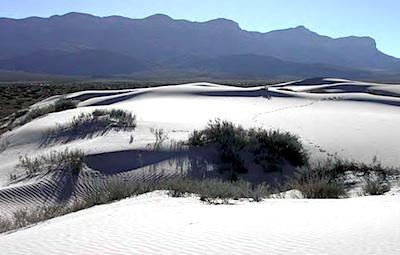What, if anything, should the National Park Service do to enhance visitor amenities at Salt Basin Dunes in Guadalupe Mountains National Park in Texas? That's the question the park staff has for you.
Park officials are proposing to improve visitor access to the area with a goal of increasing visitation to the scenic and ecologically unique area. Why look into moving in this direction? Because the rich geologic resources and visual beauty of the area are considered key to experiencing the park, and yet lack of visitor amenities at Salt Basin Dunes are blamed for the lack of visitation there.
The Park Service in 1988 added 10,123 acres of the Salt Basin on the western side of the park, including significant portions of the dune fields bordering the basin.
"The dunes record the existence of a large lake that gradually dried during the last 10,000 years," the park notes in its environmental assessment on the proposal. "Progressive shrinking of the lake left behind characteristic features such as coppice and parabolic dunes, saline lake deposits, shoreline terraces, and shoreline dune ridges. As the second largest gypsum dune field in the United States and the only large area of gypsum dunes outside of White Sands National Monument in New Mexico, the Salt Basin is geologically significant.
"In addition, the dunes support unusual plant associations and rare species, marking the area’s biological significance. Because of their scenic beauty, geological importance, and unusual ecosystems, The Nature Conservancy purchased 266 acres of the dunes in 1980 and managed the property as a nature preserve until transferring ownership to the NPS in 2011," the EA's narrative continues.
"Visitation to the dunes is low. On average, 180,000 to 200,000 visitors come to Guadalupe Mountains National Park each year but fewer than 400 visit the dunes. Limited access and facilities are the primary reasons for the low visitation. Access to the western part of the park containing the dunes requires a nearly 90-mile round trip to get the gate key from the Pine Springs visitor center. There are no shade structures or sanitary facilities at the dunes, making visitation especially problematic during the summer months when temperatures can exceed 100°F. Summer storms may produce heavy rains that can make the access road impassable for days or weeks at a time. Finally, there are no interpretive materials at the dunes to inform visitors about their experience."
Currently, all that exists at the site for visitors is a 50-foot by 75-foot gravel parking area. In their EA, park staff have identified four alternatives:
* No action
* Install a shade structure and odor-free vault toilet at the existing location with an RV turnaround adjacent to the entrance gate to the Salt Basin Dunes;
* Construct a new parking lot with RV turnaround and Shade Structure and odor-free vault toilet approximately 1.5 miles northwest of the existing parking lot, and;
* Construct a new parking lot with RV turnaround, Shade Structure and odor-free vault toilet approximately 0.3 miles due west of the existing parking lot.
Each of the action alternatives would develop an area up to 1 acre in size for parking spaces for up to 10 cars and three recreational vehicles, a vault toilet, a picnic shelter, and interpretive displays describing the natural and cultural history of the dunes.
Public comment on the EA is being taken through December 10. You can read the EA, and leave your comments, at this site. The EA contains the following description of the Salt Basin Dunes area:
The white gypsum sands of the Salt Basin Dunes rise 100 feet from the desert floor and provide a brilliant contrast to the dark, towering cliffs of the Guadalupe Mountains. To the west are barren salt flats that are the source of these beautiful dunes. When rain runs off the highly soluble limestone rock in the adjacent mountains, salts are leached. This runoff pools in the desert basin and as it evaporates, large grains of mineral salts are left behind. The wind carries the salt grains northeast toward the Guadalupe Mountains and deposits them at the base of the western Guadalupe escarpment to form gypsum dunes.
The dune landscape is geologically young. It developed over the past few thousand years as dissolved salts and gypsum from an adjacent lake bed were deposited by wind into ever changing sculpted hill, swale, and ripple formations. The mesquite coppice dunes form stabilized spots where wildlife abounds.
The dunes environment is home to gypsum-loving plant and animal life such as gypsum scalebroom, a white variant of the lesser earless spiny lizard, and five of the park’s seven species of scorpions.Numerous hearths, rock, and flaking sites attest to prehistoric use. This area has been identified by the Tigua Indians of Ysleta del Sur as culturally and spiritually significant. Water wells and windmills demonstrate more recent historic ranching uses.


 Support Essential Coverage of Essential Places
Support Essential Coverage of Essential Places







Comments
My wife says she's not going anywhere unless there's a toilet and cold water.....LOL